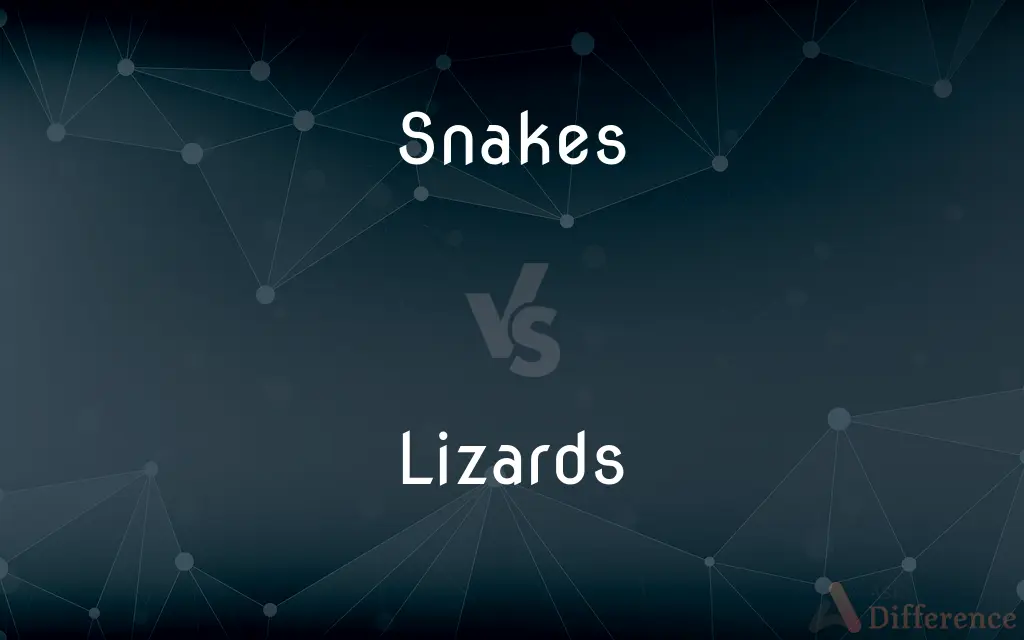Snakes vs. Lizards — What's the Difference?
By Tayyaba Rehman — Published on November 19, 2023
Snakes are legless reptiles with elongated bodies; lizards typically have legs and external ear openings. Both belong to the Squamata order.

Difference Between Snakes and Lizards
Table of Contents
ADVERTISEMENT
Key Differences
Snakes are a distinct group of reptiles known for their legless appearance and elongated bodies. While many associate them with slithering movements and venomous species, snakes encompass a vast range of species, from constrictors to non-venomous varieties. Their lack of eyelids and external ears distinguishes them from many other reptiles.
Lizards, on the other hand, are a broad group of reptiles that typically possess four legs, though some species might look legless. Unlike snakes, lizards have eyelids, and most have external ear openings. Their skin is covered in overlapping scales, and many species can regenerate their tails if they break off, a feature not commonly seen in snakes.
Despite their differences, snakes and lizards share some common characteristics. Both belong to the order Squamata and have evolved various methods to adapt to their environments. For instance, certain desert-dwelling lizards and snakes have developed ways to move efficiently on sand, even though their methods of movement might differ.
The way snakes and lizards reproduce can vary. While many snakes lay eggs, some give birth to live young. Lizards, in contrast, primarily lay eggs, though a few species also give birth to live offspring. Interestingly, certain lizards, such as the Komodo dragon, can reproduce through parthenogenesis, a process where females produce offspring without mating.
Dietary habits between snakes and lizards can differ as well. While snakes are predominantly carnivorous, feeding on animals ranging from insects to larger mammals, lizards have varied diets. Some lizards are herbivores, others are carnivores, and yet others are omnivores, consuming both plant and animal matter.
ADVERTISEMENT
Comparison Chart
Limbs
Typically legless.
Mostly have four legs.
Ear Openings
No external ear openings.
Most have external ear openings.
Eyelids
No eyelids; a clear scale covers the eye.
Have movable eyelids.
Reproduction
Lay eggs or give birth to live young.
Primarily lay eggs; some bear live young.
Dietary Habits
Predominantly carnivorous.
Can be herbivores, carnivores, or omnivores.
Compare with Definitions
Snakes
Carnivorous reptiles that can be venomous or non-venomous.
Venomous snakes use their venom to immobilize or kill prey.
Lizards
Reptiles, usually with four legs, belonging to the suborder Lacertilia.
Lizards are diverse, with species like geckos, iguanas, and chameleons.
Snakes
Reptiles lacking eyelids and external ear openings.
The eyes of snakes are protected by a transparent scale.
Lizards
Reptiles with movable eyelids and external ear openings.
Lizards can blink, unlike their snake counterparts.
Snakes
Known for their ability to shed their skin in one piece.
As snakes grow, they periodically shed their old skin.
Lizards
Creatures with overlapping scales and the ability to regenerate lost tails.
Many lizards drop their tails as a defense mechanism.
Snakes
Reptiles that can either lay eggs or give birth to live young.
Some snakes, like pythons, incubate their eggs by coiling around them.
Lizards
Diverse in diet, ranging from herbivorous to carnivorous habits.
While some lizards munch on plants, others hunt insects and small animals.
Snakes
See Shoshone.
Lizards
Animals that communicate through body language and color changes.
Chameleons change color based on mood, temperature, and communication needs.
Snakes
See Hydra.
Lizards
Any of numerous squamate reptiles often classified in the suborder Lacertilia, characteristically having a scaly elongated body with a tapering tail, four legs, movable eyelids, and external ear openings.
Snakes
Any of numerous scaly, legless, sometimes venomous squamate reptiles of the suborder Serpentes (or Ophidia), having a long, tapering, cylindrical body and flexible jaws.
Lizards
Leather made from the skin of one of these reptiles.
Snakes
A treacherous person. Also called snake in the grass.
Lizards
Plural of lizard
Snakes
A long, highly flexible metal wire or coil used for cleaning drains. Also called plumber's snake.
Snakes
To drag or pull lengthwise, especially to drag with a rope or chain.
Snakes
To pull with quick jerks.
Snakes
To move in a sinuous or gliding manner
Tried to snake the rope along the ledge.
Snakes
To move with a sinuous motion
The river snakes through the valley.
Snakes
Plural of snake
Snakes
Legless, elongated reptiles belonging to the suborder Serpentes.
Snakes can be found in various habitats, from forests to deserts.
Common Curiosities
How do lizards differ from snakes in appearance?
Lizards typically have legs and external ear openings, whereas snakes are legless and lack external ears.
What are snakes?
Snakes are legless reptiles with elongated bodies, belonging to the suborder Serpentes.
Can lizards regenerate any body parts?
Yes, many lizards can regenerate their tails if lost.
Are lizards carnivorous like snakes?
Lizards can be carnivorous, herbivorous, or omnivorous, whereas snakes are primarily carnivorous.
Do lizards have venom like some snakes?
A few lizard species, like the Gila monster, produce venom, but it's less common than in snakes.
Can snakes blink?
No, snakes lack movable eyelids and have a transparent scale over their eyes.
Do both snakes and lizards lay eggs?
While most snakes and lizards lay eggs, some snakes and a few lizards give birth to live young.
Are snakes and lizards cold-blooded?
Yes, both snakes and lizards are ectothermic, meaning they regulate their body temperature using their environment.
Are all snakes venomous?
No, only certain species of snakes are venomous.
How do lizards communicate?
Lizards use body language, vocalizations, and sometimes color changes for communication.
What's the largest species of lizard?
The Komodo dragon is the largest lizard species.
Why don't snakes have legs?
Snakes evolved from lizard-like ancestors, losing their limbs over time for a more burrowing and streamlined body.
How do snakes move without legs?
Snakes use various locomotion methods, like sidewinding or concertina movement, to move without limbs.
Are snakes and lizards closely related?
Yes, both snakes and lizards belong to the order Squamata, making them closely related reptiles.
Are there lizards without legs?
Yes, some lizards, like the glass lizard, appear legless but are distinct from snakes.
Share Your Discovery

Previous Comparison
Google vs. Google Chrome
Next Comparison
Red Curry vs. Green CurryAuthor Spotlight
Written by
Tayyaba RehmanTayyaba Rehman is a distinguished writer, currently serving as a primary contributor to askdifference.com. As a researcher in semantics and etymology, Tayyaba's passion for the complexity of languages and their distinctions has found a perfect home on the platform. Tayyaba delves into the intricacies of language, distinguishing between commonly confused words and phrases, thereby providing clarity for readers worldwide.











































